
About UsThe Numismatic Bibliomania Society is a non-profit organization promoting numismatic literature. For more information please see our web site at coinbooks.org SubscriptionsThose wishing to become new E-Sylum subscribers (or wishing to Unsubscribe) can go to the following web page link MembershipThere is a membership application available on the web site Membership Application To join, print the application and return it with your check to the address printed on the application. Membership is only $15 to addresses in the U.S., $20 for First Class mail, and $25 elsewhere. For those without web access, write to: David M. Sundman, Secretary/TreasurerNumismatic Bibliomania
Society AsylumFor Asylum mailing address changes and other membership questions, contact David at this email address: dsundman@LittletonCoin.com SubmissionsTo submit items for publication in The E-Sylum, just Reply to this message, or write to the Editor at this address: whomren@coinlibrary.com
BUY THE BOOK BEFORE THE COINYou won't regret it! |
- WAYNE'S WORDS: THE E-SYLUM JANUARY 8, 2012
- SKLOW NUMISMATIC LITERATURE SALE CALENDAR 2012-2013
- NEW BOOK: ODD & CURIOUS AND TRADITIONAL MONEY
- NEW BOOK: COUNTERFEIT COINS OF ROMAN BRITAIN
- NEW BOOK: OTTOMAN EMPIRE COINS: 1839-1918, 2ND EDITION
- KRAUSE PUBLICATIONS CELEBRATES 60 YEARS IN 2012
- ERROR TRENDS COIN MAGAZINE CEASES PUBLICATION
- RONALD SEARLE 1920-2012
- ARE DOG LICENSE TAGS EXONUMIA?
- COMMENTS ON EXONUMIA AND EXOGRAPHICA
- THE LEGACY OF RAPHAEL THIAN
- QUERY: INFORMATION ON JEAN CASTAING SOUGHT
- BEP EXPANDS ITS WATCHLIST TO INCLUDE CONTRACTORS
- NOTES FROM E-SYLUM READERS: JANUARY 8, 2012
- THE EURO'S TENTH ANNIVERSARY
- MORE ON HOLEY DOLLARS
- ROMAN BROTHEL TOKEN UNCOVERED IN LONDON
- PAUL MANSHIP'S 1930 HAIL TO DIONYSUS MEDAL
- NUMISMATIC NEWS SURVEY READERS SPLIT ON STEEL CENTS
- STORIES ABOUT THE STORIED 1804 SILVER DOLLAR
- ANS SPANISH COINS ON DISPLAY IN NEW YORK
- NATIONAL MUSEUM OF AUSTRALIA BUILDS MEDAL COLLECTION
- MYSTERY 'GOLD INGOTS' FOUND ON PARIS TRAIN
- ARTICLE HIGHLIGHTS WASHINGTON'S BOOKHOUSE
- THIEF PUTS COLLECTION INTO COINSTAR MACHINE
- WALMART CUSTOMER SPENDS $1 MILLION BILL (OR TRIES TO)
- FEATURED WEB SITE: THAMES AND FIELD METAL DETECTING SOCIETY
WAYNE'S WORDS: THE E-SYLUM JANUARY 8, 2012

We have no new subscribers to report this week. We have 1,489 email subscribers, plus 170 followers on Facebook.
This week we open with a sale calendar update from David Sklow and information on three new numismatic books. Other topics this week include an anniversary for Krause Publications, Thian Confederate note albums, the Euro's tenth anniversary and a Roman brothel token found in England.
To learn more about Jean Castaing, Ed Krivoniak's mystery coin, the 1804 Tripoli dollar legend, Londinium brothels, the Thames and Field metal detecting society and the Cow Yielding Largest Quantity of Butter Fat, read on. Have a great week, everyone!
Wayne Homren
(whomren@gmail.com)
Numismatic Bibliomania Society
SKLOW NUMISMATIC LITERATURE SALE CALENDAR 2012-2013
Numismatic literature dealer David Sklow writes:
Below is my auction schedule for 2012 & 2013.
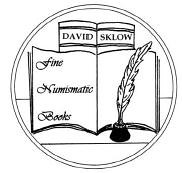 Sale # 15 - Closes February 11, 2012
Sale # 15 - Closes February 11, 2012
Sale # 16 - Closes June 2, 2012
Sale # 17 - Closes October 6, 2012
Sale # 18 - Closes February 2, 2013
Sale # 19 - Closes June 1, 2013
Sale # 20 - Closes October 5, 2013
David Sklow-Fine Numismatic Books
P.O. Box 6321
Colorado Springs, CO 80934
PH: 719-302-5686
FAX: 719-302-4933
EMAIL: numismaticbooks@aol.com
WEB: FineNumismaticBooks.com
NEW BOOK: ODD & CURIOUS AND TRADITIONAL MONEY
 Charles Opitz has just released his newest book on odd & curious money. This 840 page digital book has over 2,800 full color pictures and is one of the first all digital books on the subject. It is in the same format as "A Ethnographic Study of Traditional Money" also by Charles Opitz. It is an expanded version of his previous book and it will replace that book. The digital book covers the entire world of odd & curious money including sycee, throwing knives, wampum, shell money, beads, Yap stones, mokos, manilla varieties, salt money, tea money, playing card money, bullet money, and axes.
Charles Opitz has just released his newest book on odd & curious money. This 840 page digital book has over 2,800 full color pictures and is one of the first all digital books on the subject. It is in the same format as "A Ethnographic Study of Traditional Money" also by Charles Opitz. It is an expanded version of his previous book and it will replace that book. The digital book covers the entire world of odd & curious money including sycee, throwing knives, wampum, shell money, beads, Yap stones, mokos, manilla varieties, salt money, tea money, playing card money, bullet money, and axes.
A section of the book details three trips taken by Charles Opitz to 1973 Papua New Guinea, 1995 Trobriand Islands and 2003 Yap & Palau. On the trips Opitz purchased many traditional money items, many of which were still being used by the natives. The bibliography lists more than 600 books used in the research. Most of the pictures are of pieces in Opitz's collection.
The CD is only available from the author, Charles Opitz, 2471 SW 37 St., Ocala, FL 34471 at a cost of $5.00 plus $3.00 postage for a total of $8.00. The postage is for both US and foreign.
[1/18/2021: This book is now freely available on NNP at https://nnp.wustl.edu/library/book/541824.]
NEW BOOK: COUNTERFEIT COINS OF ROMAN BRITAIN
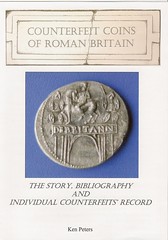 The author Ken Peters has, after years of tracking down, sifting, extracting, assembling and amalgamating, produced a one-stop centre of information on all aspects of coin counterfeiting in Roman Britain.
The author Ken Peters has, after years of tracking down, sifting, extracting, assembling and amalgamating, produced a one-stop centre of information on all aspects of coin counterfeiting in Roman Britain.
The basic arrangement is chronological, following the useful, generally accepted twenty-one periods of Roman Britain devised by Richard Reece.
In the book, the story of Roman counterfeiting is followed by a detailed and extensive Bibliography, plus descriptions and location references for hundreds of specific Roman counterfeits, many illustrated. The Bibliography is enhanced by small references being quoted in full, saving the need to seek them out.
Other featured sections include Roman Coin Hoards with counterfeit elements, Roman counterfeits in British Museums, coiners and their fakes, ancient laws, identifying counterfeits, etc.
COUNTERFEIT COINS OF ROMAN BRITAIN comprises two hundred A4 pages of concentrated information, precisely arranged for maximum accessibility – and all for just £25 - undoubted value for money.
Available from Envoy Publicity, 8 Kings Road, Biggin Hill, Kent, TN16 3XU, England @ £25 + £2.50 p&p (England); £5 Europe; £12 rest of the world.
NEW BOOK: OTTOMAN EMPIRE COINS: 1839-1918, 2ND EDITION
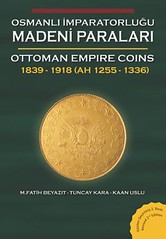 The first book of our "Ottoman Empire Coins Series" was out of print at the end of 2010.
Completely updated second edition of this first book is ready.
The first book of our "Ottoman Empire Coins Series" was out of print at the end of 2010.
Completely updated second edition of this first book is ready.
For more information, see:
www.ebay.com/itm/320818333866?
ssPageName=STRK:MESELX:IT&_trksid=p3984.m1555.l2649
KRAUSE PUBLICATIONS CELEBRATES 60 YEARS IN 2012
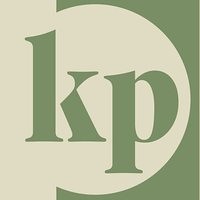 Krause Publications, a leading producer of books, magazines, events and online products for the coin and paper money collecting hobbies, will celebrate its 60th year in business in 2012.
Krause Publications, a leading producer of books, magazines, events and online products for the coin and paper money collecting hobbies, will celebrate its 60th year in business in 2012.
Chet Krause created Numismatic News from his mother's kitchen table in rural Iola, Wis., in 1952. A carpenter by trade, Krause was also a coin collector looking for a way to connect with other collectors around the country.
From the launch of this magazine, the Krause Publications numismatic media portfolio came to include magazines such as Coins, World Coin News and Bank Note Reporter; books like the revolutionary Standard Catalog of World Coins, North American Coins and Prices and U.S. Coin Digest; events like the Chicago International Coin Fair and Chicago Paper Money Expo; and websites like NumisMaster.com.
The company also diversified to include other enthusiast media properties in areas such as automobiles, antiques, records, firearms and knives, and hunting.
Krause Publications was acquired by Cincinnati-based F+W Media in 2002, but continues to operate primarily from its Iola offices.
"We are honored and humbled to be celebrating 60 years of serving such a wonderful hobby," said KP numismatics publisher Scott Tappa. "Thousands of hobbyists have used our products over the years to deepen their appreciation of collecting, and we thank every one of them for giving us the opportunity to serve them. This year we remember fondly the last 60 years while at the same time laying the foundation for the next 60 years!"
KP plans to mark its 60th anniversary with a variety of special products and events over the course of 2012. More details will be released in the months ahead.
Long-time KP staff members such as Dave Harper, Bob Van Ryzin, Tom Michael or George Cuhaj are available to speak further about KP's anniversary. Please contact Tappa at scott.tappa@fwmedia.com for more information.
ERROR TRENDS COIN MAGAZINE CEASES PUBLICATION

Image from Ken Potter Numismatic Books & Supplies site
Paul Gilkes reported in the January 16, 2012 issue of Coin World that Error Trends Coins Magazine has ceased publication. Production was suspended nearly a year ago when published Arnold Margolis, now 86, had a stroke. Although Arnie is at home recovering, the cessation has become permanent.
I helped Arnie create a web site for his magazine several years ago and would periodically help him with questions and problems. ETCM was a pioneering publication in the error field. Arnie is also the author or coauthor of several books on the topic. We wish him luck on his continuing recovery.
THE BOOK BAZARRE
RONALD SEARLE 1920-2012
Scott Miller writes:
It may be of interest to some that Ronald Searle passed away recently. In addition to his many other works, he was a medalist of some note, having designed medals for the British Art Medal Society, Paris Mint, and others.
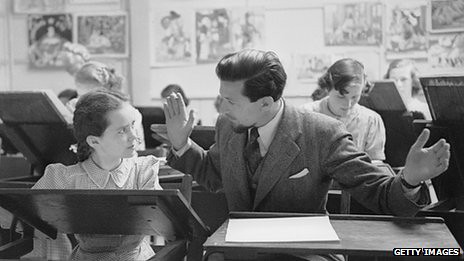
Born in Cambridge in 1920, his talent as an artist was clear early on. Even as a teenager his cartoons appeared in the local newspaper. Then, when World War II started, Searle joined the army.
At 22, he was captured in Singapore by the Japanese. He spent the rest of the war in appalling, lethal conditions - at first in prison and then as a forced labourer, building the Burma railway in Thailand
He later said that what he witnessed as a prisoner of war marked him for life. "I was in conditions of total isolation, total brutality - it was slavery. I woke up day after day with men dead on each side of me."
Searle made hundreds of small sketches of the squalor and misery, sometimes hiding them under the bodies of men dying of cholera and fever.
He did not expect to survive.
"What kept me going was that, if I could only show people what it had been like, I would have achieved something in the short life I was likely to have."
But he did make it through the war, and returned to Britain to begin a slow return to physical health. Soon, he was supplying cartoons to magazines of the day such as The Strand and Punch.
To read the complete article, see: Obituary: Ronald Searle (www.bbc.co.uk/news/entertainment-arts-16395263)

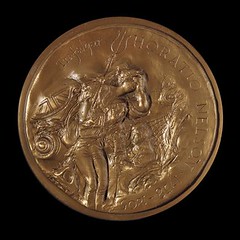
ARE DOG LICENSE TAGS EXONUMIA?
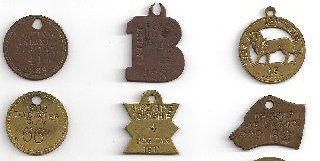
Pete Smith writes:
I must take exception to your characterization of dog license tags as a non-numismatic collectible.
Dog license tags are included in Tokens and Medals A Guide to the Identification and Values of United States Exonumia by Alpert and Elman.
I met William Bone at the National Token Show in Omaha and include his tokens with my tokens of numismatists.
License tags represent the payment of a fee or tax good until a future date. Similar items include cat license tags, cattle tags, and horse tags. While full size auto license plates are not included in the Alpert / Elman book, miniature auto license plate tags are included. Also not representing the payment of a fee are military dog tags and other personal identification tags like key tags.
The field of exonumia is very vast and there is a collector for everything.
How do our paranumismatists on the other side the the pond classify such items? Are they considered paranumismatic? -Editor
To read the earlier E-Sylum article, see: A DOG LICENSE TAG COLLECTION (www.coinbooks.org/esylum_v15n01a22.html)
COMMENTS ON EXONUMIA AND EXOGRAPHICA
John Mutch writes:
Personally, I have never liked the term, "Exonumia". Rulau's reasoning for inventing it was never explained to me, so I was left with the explanation, "exo = outside of, and numia = numismatics". To me the word implies that tokens, medals, and such were outside of the realm of Numismatics.
My belief is that there is much more Numismatics going on with medals and tokens than there is with coins. To my way of thinking, much of the research on the entire series of United States coins has been done and has been nicely summarized in the Guide Book of United States Coins.
Medals, and especially tokens (expressing my own selfish interests here), offer almost unlimited opportunity for ORIGINAL research which is what Numismatics is all about. A person who makes a living buying and selling slabbed (identified, graded, and authenticated) coins by looking up values in the gray sheet or by buying silver by weight and fineness then selling it to a refinery is not a Numismatist! Given almost any medal or token, answering the "Five Ws and one H" questions, Who, What, Where, When, Why, and How? will involve some serious research.
Some may feel a need for a word such as Exonumia, but for me, Numismatics is the word to use. Similarly, I don't think Neil Shafer's term, Exographia, has a use. If the paper item of interest is Numismatic, then it Numismatics is the word to use. If it is other than that, the well-accepted term, Ephemera, is appropriate.
To read the earlier E-Sylum article, see: NEW WORD: EXOGRAPHICA (www.coinbooks.org/esylum_v15n01a12.html)
THE LEGACY OF RAPHAEL THIAN
Today Raphael Prosper Thian (April 5, 1830-Dec. 19, 1911), CSA note and bond collector, cataloger, dealer, archivist and recorder, Confederate Treasury document compiler, and unofficial Rebel Archives note custodian, stands in the front rank of contributors to the course of CSA paper money collecting.
Thian's place in the pantheon of CSA currency "heroes" was much less prominent or secure, however, when he died a little over a century ago.
At the time of his death Thian's most significant contribution to the evolution of Confederate note collecting was the collectors album he made and sold. Thirty-five years earlier, Thian had produced the first commercial album for collectors of CSA currency with pre-determined spaces to fill. This gives us a sense that by 1876, when Thian released his album, the Confederate paper money hobby was maturing a bit. Soon he had a more aggressive competitor in dealer C.H. Bechtel's Album for Confederate Currency (1877).
Thian's Confederate Note Album for a Complete Collection (with descriptive letter-press) of the various designs for face and back selected by the Confederate Treasury Authorities for the Currency of the Confederate States of America, 1861-1865, was privately published by its author in the year of the U.S. Centennial. The album had spaces for mounting notes from the Montgomery $1,000 down. It's importance should not be underestimated.
Thian's albums are known in three sizes, but readers should not be confused about what I am referring to here. I am talking about Thian's "retail" albums, comprised of 44 leaves/88 pages, which were (presumably) sold both with some/many notes in place, or blank for do-it-yourselfers.
Regarding these "retail" albums, Thian published and and sold a small quantity (one estimate is 25) filled with notes, and also sold an unknown quantity of these "retail" small albums without notes to collectors, who desired to build their own "complete" sets of Rebel notes.
I am not talking about the various presentation albums of approximately 200+ leaves/400+ pages, nor the monster master albums he compiled for his own purposes with up to 320 or more leaves/640 pages. The presentation albums were prepared at various times for dignitaries, sometimes titled on their covers more simply The Currency of the Confederate States.
To read the complete article, see: Thian's Legacy: A Tale of Two Halves (www.numismaster.com/ta/numis/Article.jsp?ad=article&ArticleId=24571)

QUERY: INFORMATION ON JEAN CASTAING SOUGHT
We all know that the Castaing machine was used in the Philadelphia Mint to impart the edge lettering on the half cents, cents, half dollars and dollars. Everyone also agrees that Jean Castaing, a French engineer, developed the machine in the late 1600's. I have been looking for additional information on Castaing for some time.
I have the works by Denis Cooper, Taxay and Breen, but am looking for additional information on Castaing himself. Can any of the E-Sylum readers suggest a book or other article I have missed? Thank you in advance for your assistance, Pete Smith.
BEP EXPANDS ITS WATCHLIST TO INCLUDE CONTRACTORS
 The Treasury Department's Bureau of Engraving and Printing, which like many federal agencies maintains investigative files on past and present employees and its contractors -- so it can perform background investigations on these individuals -- has decided to add another specific group to that list -- employees of companies to which the Bureau supplies samples of Federal Reserve notes or other government securities.
The Treasury Department's Bureau of Engraving and Printing, which like many federal agencies maintains investigative files on past and present employees and its contractors -- so it can perform background investigations on these individuals -- has decided to add another specific group to that list -- employees of companies to which the Bureau supplies samples of Federal Reserve notes or other government securities.
"This amendment will allow BEP to collect and maintain background investigation records on individuals who do not work for BEP or for any of its contractors or service providers," explains a Treasury Department notice published in the Federal Register on Jan. 6.
In another change to its Privacy Act system of records, the BEP also announced that it will begin collecting and maintaining passport numbers, which "may be the one record available," when its new policies take effect on Feb. 10, "unless the BEP receives comments that would result in a contrary determination."
Members of the public can comment on these proposed changes by sending an email to Keir Bancroft, the BEP's chief privacy officer, at Keir.Bancroft@bep.gov by Feb. 6.
To read the complete article, see: Bureau of Engraving will soon be able to investigate manufacturers of banknote equipment and currency readers (www.gsnmagazine.com/node/25382?c=federal_agencies_legislative)
NOTES FROM E-SYLUM READERS: JANUARY 8, 2012
Alan Weinberg on the 2012 FUN Show
Alan V. Weinberg writes:
I returned late Sat evening from the annual January Orlando FUN show. Here are my impressions:
I simply cannot remember, in easily 2+ decades of attendance, when I was not impressed with the January FUN show. It attracts most serious numismatists across the country, despite the directly conflicting NYC International Show which, I'm told, many dealers and collectors choose not to attend due to the costs involved.
The FUN bourse was huge, reportedly something like 575 bourse tables sold, considerably more than last year's Tampa show (which itself was nothing to sneeze at despite prior woeful predictions). Despite the mediocre attendance and somewhat depressed atmosphere ( the economy ) of other recent major shows I've attended, this was NOT the case for this FUN show. Collector attendance was HUGE, there was an exciting and enthusiastic "buzz" in the air, and there was not the often-seen massive departure of dealers from Sat noon on - few dealers left when I departed at 5 PM Sat. The show ran thru Sunday. Roaming the aisles constantly since 2 PM Wed setup started, I did not overhear one single negative or even mediocre comment relating to sales or attendance. This was simply a convention from the past when things were great in the hobby and the economy was vibrant.
Ironically, Orlando itself does not reflect this optimism. When I arrived early Wed morning, my driver commented the city was "dead" ( nice hotel rooms near the convention center were avail for $45-50 via discount websites ). I learned that the massive Orange County Convention Center - always completely full in past years to the point that FUN was forced to move to Tampa last year (which itself was quite successful despite prior woeful predictions) due to the Orlando Convention Center being sold out - was completely empty and unbooked except for FUN. Whadda contrast with prior years !
The directly conflicting NYC International Coin Show did not seem to have any impact on FUN's success. In fact, I overheard more than a few times that many dealers and collectors chose FUN over NYC due to the high bourse and hotel expenses connected with the latter show.
There were many exquisite buying opportunities on the bourse floor. I personally acquired a gem proof silver Thomas Elder portrait medal DeLorey 1, a choice Ft Sill Indian Territory Post Canteen 25c, a full gilt Unc Ft Quitman Texas Post Trader 10c shellcard. a choice Uncirculated advertising encased 1912 Barber dime - only the 2nd encased Barber dime I've seen in many decades, a silver and gold Cincinnati assay company's celluloid advert turtle, etc. Items that simply do not turn up and are 1000x rarer than 99.9% of rare coins. I did not acquire any rare coins - the Loring 1793's either sold too high or did not meet my expectations. CRO had a really choice Noe 1 Pine Tree shilling that sold quickly to another serious Southern California collector.
Simply put, the FUN people really know how to please bourse dealers and collectors - from the cost of bourse tables (on average 1/2 or less the cost of ANA tables), great complimentary transportation to and from area hotels, excellent law enforcement security , daily breakfast for dealers, outstanding exhibits (I exhibit something special every January because of the show's quality and attendance) , a superb convention facility and the ability to attract collectors from all over the country. The hobby is again "oldtime enjoyable".
Titanic artifacts
Gary Niditch writes:
I had a chance to see the Titanic artifacts several years ago while they were on display in Chicago. I would encourage anyone who has a chance to see the exhibit to do so. It is both very interesting and very moving.
Besides paper money there are numerous things to see. I found myself most moved by passengers tickets, especially those originally scheduled for a different ship but then changed to the Titanic.
Reaching through a plexiglass opening one was allowed to touch the metal hull, an exciting experience after having heard so much about the Titanic over the years.

This image shows the 17-ton section of the RMS Titanic that was recovered from the ocean floor during an expeditions to the site of the tragedy, on display. The piece along with 5,000 other artifacts will be auctioned as a single collection on April 11, 2012 100 years after the sinking of the ship. AP Photo/RMS Titanic, Inc.
For more information on the exhibit and sale, see: www.rmstitanic.net
To read the earlier E-Sylum article, see: TITANIC ARTIFACTS TO BE AUCTIONED IN 2012 (www.coinbooks.org/esylum_v15n01a21.html)
Mystery Coin: Colombia 200 Pesos
Regarding Ed Krivoniak's mystery coin from The Epic History of Everyday Things , Rich Hartzog writes:
I am not sure, but this looks like one of the Japanese arcade tokens (pachislo). There are a huge number of varieties, mostly nickel-silver and about quarter-size. In my multi-ton hoards of vending and arcade bags I constantly find these, generally without inscriptions.
Nicolás Santerini writes:
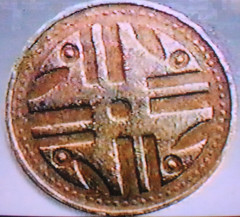 The coin unidentified from "The epic history..." is from Colombia, KM # 287, 200 pesos years 1994, 95 and 96.
Greetings from Uruguay, your newest subscriber.
The coin unidentified from "The epic history..." is from Colombia, KM # 287, 200 pesos years 1994, 95 and 96.
Greetings from Uruguay, your newest subscriber.
To read the earlier E-Sylum article, see: QUERY: UNIDENTIFIED COIN FROM THE EPIC HISTORY OF EVERYDAY THINGS (www.coinbooks.org/esylum_v15n01a16.html)
DAMIN Silver Monetary Depreciation and International Relations
Georges Depeyrot writes:
With the beginning of our program of study DAMIN Silver Monetary Depreciation and International Relations a web site is now in construction, www.anr-damin.net .
You will find the main links to the project, the main participants, to the program of the first round-table at Paris, January 13-14 and to the first volumes published.
Baldwin's Prospero Collection Sets Records
The much anticipated sale of the spectacular Prospero Collection concluded at 03.30 EST this morning and, after a phenomenal eight hour ‘white glove' auction, the team at Baldwin's had a lot to smile about. Although results are still in the process of being confirmed initial figures released by the company state that the sale total for all 642 lots is approximately US$25,000,000 (including buyer's premium at 17%), more than double the pre-sale estimate.
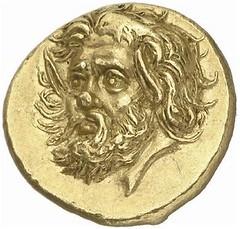 Lot 213, the catalogue cover coin, broke all previous world records for an ancient Greek coin, selling for a phenomenal US$3,250,000 (hammer). This beautiful example of a Gold Stater from Pantikapaion depicts the head of a satyr, a character widely used in Greek mythology. The coin is one of the most spectacular numismatic objects to have survived from the classical world and is one of the greatest and admired of all the ancient Greek coins. This miniature work of art is an incredibly rare artistic masterpiece and it was no surprise when bidding soared past the pre-sale estimate of US$650,000.
Lot 213, the catalogue cover coin, broke all previous world records for an ancient Greek coin, selling for a phenomenal US$3,250,000 (hammer). This beautiful example of a Gold Stater from Pantikapaion depicts the head of a satyr, a character widely used in Greek mythology. The coin is one of the most spectacular numismatic objects to have survived from the classical world and is one of the greatest and admired of all the ancient Greek coins. This miniature work of art is an incredibly rare artistic masterpiece and it was no surprise when bidding soared past the pre-sale estimate of US$650,000.
To read the earlier E-Sylum article, see: BALDWIN'S PROSPERO COLLECTION OF GREEK COINAGE SALE (www.coinbooks.org/esylum_v14n31a12.html)
Washington Before Boston Medal Question
Ron Ward writes:
Please check out eBay lot#130623237677, a silver-plated copper version of the Washington Before Boston medal (the seller also lists a number of other military medals silver-plated). I asked him if there were any edge markings since he said it came from the Paris mint. He replied there were none - which should have been present. I think something is wrong - could these be new Chinese imports? As readers may recall, there were some very nice EF-Unc Lafayette dollars floating around several years ago. What are your thoughts?

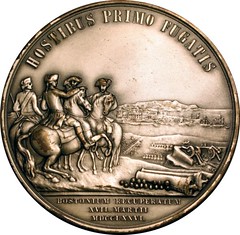
Click here to view the eBay lot description: 1776 George Washington Before Boston Medal Silvered-Bronze
THE EURO'S TENTH ANNIVERSARY
Harry Watterson writes:It's not often you see a numismatic library in the New York Times and a coin critique.
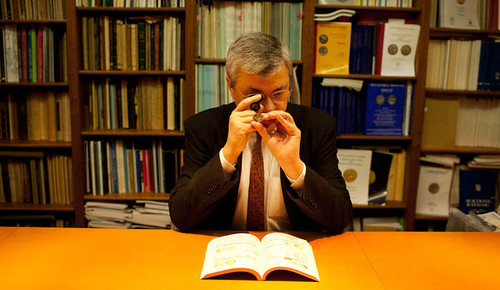
In Brussels, there will be neither a ceremony nor even a news conference to mark the occasion. That set the tone for other countries, many of which were doing the minimum: preparing to circulate a 2-euro commemorative coin for the anniversary.
The coin features the kind of generic symbols — a family, a ship, a factory and wind turbines — that have earned the euro a reputation as a currency designed by committee not to offend anyone, but unlikely to inspire, either.
But the euro has conjured little of the affection or patriotism that the dollar evokes in America, no nickname comparable to the greenback. The fondest memories are reserved for the old national currencies.
For Ivan Grossi, a sales representative who works in Rome, the advent of the new currency was never much to celebrate. "I grew up with the lira, it was like one of the family, and I felt an enormous sadness when the euro was introduced," he said.
Jason Charbit, a Frenchman studying business across the channel in London, called the euro bills "Monopoly money." "Franc bills were more solid," he said. "You had the impression you had real money."
Michel Prieur, a numismatist in Paris and a member of the collectors group The Friends of the Euro, said that if policy makers were trying to create warm feelings toward their currency, they had gone about it all wrong, with sterile architectural designs on the bills. Coins usually have national designs on the back, but the bills have "bridges that come from nowhere and that lead nowhere" and "windows that open onto nothing," he said.
To read the complete article, see: No Fireworks for Euro as It Reaches the 10-Year Mark (www.nytimes.com/2012/01/01/world/europe/euro-is-10-years-old-but-few-are-celebrating.html)
MORE ON HOLEY DOLLARS
Regarding Dick Doty's question about the mint mark on the Holey Dollar acquired by the National Museum of Australia in Canberra, Ron Haller-Williams writes:It's Potosi !!! For my evidence, please go to www.nma.gov.au/collections/highlights/holey_dollar The obverse, near the top, seems to match the photo of the coin you speak of. The reverse, with "PTSI" monogram, is just over half-way down.
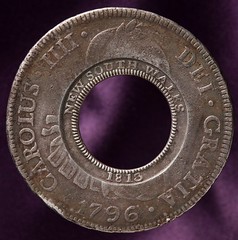
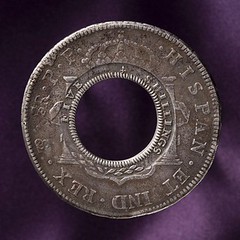
Adrián González Salinas compiled the following information. Thanks!
The National Museum of Australia spent AUS$130,000 (hammer price AUS$111,000) to acquire a rare 1813 "holey dollar," Australia's first official minted currency, at the International Auction Galleries' Australian & World Rare Coin auction on November 6th. There are only 300 or so holey dollars extant and this particular piece is one of only five which originated from Potosi, Bolivia.
Source: http://www.thehistoryblog.com/archives/14157
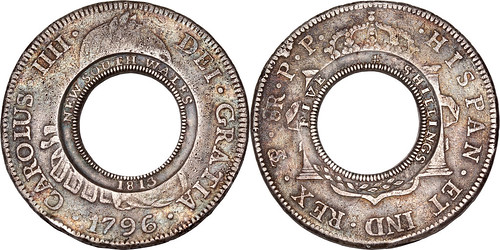
The complete Holey Dollar (obverse and reverse): http://www.thehistoryblog.com/wp-content/uploads/2011/12/NSW-Holey-Dollar.jpg
More Info: This Holey Dollar 1813 (1796/5) of the scarce Potosi Mint type and with fantastic old provenance sold for $129,315
http://iagauctions.com/files/IAG_A75_Review.pdf
Also, I found the following and very interesting web site: www.australianstamp.com/coin-web/aust/earlyaus/holey$.htm which contains a Holey Dollar population by mint and year; including valuable information about this amazing coinage.
Using the information of above web site I did some calculations about the 8 Reales host coins:
Lima, Peru - host coins from 1780-1810 - population: 30 holey dollars (10.87%)
Madrid, Spain - host coins from 1799-1805 - population: 4 holey dollars (1.45%)
Mexico City, Mexico - host coins from 1757-1810 - population: 212 holey dollars (76.81%)
New Guatemala, Guatemala - host coin from 1800 – population: 1 holey dollar (0.36%)
Potosí, Bolivia - host coins from 1783-1808 – population: 26 monedas (9.42%)
Seville, Spain - host coins from 1793-1798 – population: 2 holey dollars (0.72%)
Plus one Holey Dollar with No Mintmark Visible (0.36%)
Total: 276 Holey Dollars
To read the earlier E-Sylum article, see: MUSEUM ACQUIRES 1813 NEW SOUTH WALES HOLEY DOLLAR (www.coinbooks.org/esylum_v14n53a16.html)
ROMAN BROTHEL TOKEN UNCOVERED IN LONDON
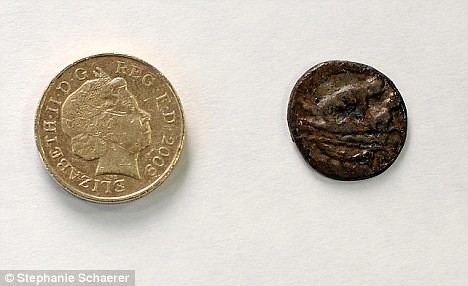
A Roman coin that was probably used by a lustful legionary has washed up on the banks of the Thames.
Made from bronze and smaller than a ten pence piece, the coin depicts a man and a woman engaged in an intimate act.
Historians believe it is the first example of a Roman brothel token to be found in this country.
It lay hidden in mud for almost 2,000 years until it was unearthed by an amateur archaeologist with a metal detector.
On the reverse of the token is the numeral XIIII, which experts say could indicate the holder handed over 14 small Roman coins called asses to buy it. This would have been the equivalent of seven loaves of bread or one day's pay for a labourer in the first century AD.
The holder would then have taken the token to one of the many Londinium brothels and handed it to a sex slave in exchange for the act depicted on the coin.
The token was found by pastry chef Regis Cursan, 37, who used a metal detector to scan the banks of the Thames near Putney Bridge in West London.
The token has been donated to the Museum of London, where it will be on display for the next three months.
Curator Caroline McDonald said: ‘This is the only one of its kind ever to be found in Great Britain.
‘When it came in, it had to be cleaned up before we could make out what it was.
‘When we realised it was a saucy picture, we had a bit of a giggle but there's also a sad story behind it because these prostitutes were slaves
Similar tokens have been found elsewhere in the Roman Empire, but this is the first time one has been unearthed in this country. Experts say there is a possibility it could also be a gaming token – although it would be the only one in Britain to display such an explicit illustration.
Historians believe that the use of a specific image was necessary because many of the brothel slaves would not have been fluent in Latin so needed a picture to know what service their client required.
It is also thought that tokens were a way of ensuring none of the customers' money went directly to the prostitutes.
Experts say it was also illegal to take Roman coins into a brothel during the reign of first century emperor Tiberius as they carried his image.
To read the complete article, see:
Dug out of the Thames mud, a token Romans used to pay for their pleasure
(www.dailymail.co.uk/news/article-2081890/Dug-Thames
-mud-token-Romans-used-pay-pleasure.html)
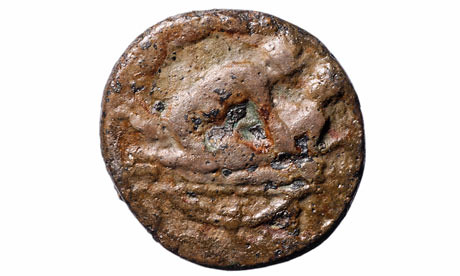
One of the oldest pieces of British pornographic art has just been discovered beside the river Thames. At first sight, the bronze disc found near Putney Bridge in London looks like an old coin – until you notice that it depicts a sex scene.
This type of bronze token with its erotic imagery was specially made to spend in ancient Roman brothels. The example found near Putney Bridge and given to the Museum of London is evidence that brothels in Roman Londinium were just as busy as they were in ancient Pompeii, where brothels and their lewd wall paintings are among the well-preserved everyday shops of a Roman town.
Yet this is not just a hint of life in Roman Britain. It is also a glimpse of a hidden art history. These Roman tokens, with their detailed depictions of sex acts, had a dramatic influence on the birth of modern pornography. While the Putney token has been hailed as a rare discovery from Roman Britain, such artefacts showing similar scenes were actually well known in Renaissance Italy.
To read the complete article, see:
Porn yesterday: Roman brothel tokens and the rise of erotic art
(www.guardian.co.uk/artanddesign/jonathanjonesblog
/2012/jan/04/porn-roman-brothel-tokens-erotic-art)
So unabashed were the people of Pompeii that they inscribed graphic images of genitalia on the paving stones, probably acting as signposts to the nearest brothel.
Prostitutes advertised their wares by carving their names, together with their sexual specialities, on walls around the town.
Everything from public arches to amphitheatres — both bustling with people — were popular pick-up spots, as were the baths, where archaeologists have uncovered explicit murals of different sexual acts between men and women, and men and men.
In the steamy atmosphere, where men and women — rich and poor — mingled naked, erotic tension ran high and it is likely that in the rooms upstairs, these tensions were released.
Bizarrely, the sex trade was aided by strict moralist Augustus when he became Emperor of Rome in 63 BC. He promoted family values and criminalised adultery.
This meant that anyone wanting extra-marital sex had to pay for it, because, in Roman eyes, paid sex did not constitute cheating. Prostitution and sex with slaves boomed even more so as a result.
To read the complete article, see: After an explicit coin used to pay for pleasure is found in the Thames, the X-rated story of the Roman sex slaves of Britain (www.dailymail.co.uk/news/article-2083295/Explicit-coin-Thames-X-rated-story-Roman-sex-slaves-Britain.html)
PAUL MANSHIP'S 1930 HAIL TO DIONYSUS MEDAL
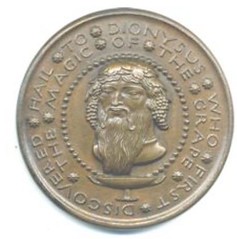

HAIL TO DIONYSUS, 1930. Murtha 265; Marqusee 256. 72.2mm. Bronze. Paul Manship, Sc. Uncirculated with an attractive chocolate bronze patina. (MACO). Original descriptive pamphlet. The obverse bears a head of Dionysus rising from a kylix (a classical Greek drinking cup). The two line legend reads: HAIL TO DIONYSUS WHO FIRST DISCOVERED/ THE MAGIC OF THE GRAPE. On the reverse, two satyrs dance out the vintage flanked by bunches of grapes.
Struck in the middle of the Prohibition era, this medal did not go unnoticed. According the Harry Rand, "The Society of Medalists second issue produced an uproar, caused by the gentlest tempest in an otherwise occupied teacup. Manship's 1930 salute to Bacchus presented the god of wine and debauchery rather too attractively for some of its viewers. Protests were received from members of the Society of Medalists and one member threatened to resign if ‘any more insults to the Constitution are perpetrated in the name of art'."
Manship stated, "So, on the reverse of the medal, two satyrs are treading the winepress. Their stupid faces, pointed ears, goat legs and tails, betray the dominance of animal instincts which their master Dionysus exemplifies. The medal is not conventional. It is subtly humorous, and is symbolic of a present-day attitude toward certain restraints of the times. Thus it is commemorative of an era." This was the 2nd issue of the Society of Medalists. $250.00
NUMISMATIC NEWS SURVEY READERS SPLIT ON STEEL CENTS
Numismatic News editor David Harper posed a question December 23 for their e-newsletter readers: Should U.S cents be abolished rather than made of steel?
Dave posted twenty replies on his web site, and published 15 responses in the January 17th issue of Numismatic News. The 15 were most representative, the 20 were evenly split ten to abolish to 10 to retain.
It is interesting that a group of coin collectors would elect to abolish with that high a percentage. I would have assumed coin collectors would have voted higher to retain. Perhaps they realized the U.S. Mint is going to make more than enough U.S. coins for collectors irrespective of the denominations available.
Here were some of the reasons to Retain:
o Simon Faj (Panama) Retain cents because they circulated in Panama. (Sorry, Simon, we cannot loose $42million or more a year to supply cents to Panama. Strike your own coins!)
o Donnie Davis (Danville Il) He wants to continue to sort through cents from change.
o An unemployed person (North Syracuse NY) Gets 6 cents for returned beverage bottles and cans and fears he would lose that 1-cent advantage. (Did you think of redeeming them in multiples of five? Or were you pulling our leg on this one?)
o Mercury Reuben Williams (Seattle WA) Believes the cent supports the economic value of the dollar. (Didn't work for the Mill at the end of the 18th century or the Half Cent in the 19th century, did it?)
o Jerry Stuart (Keller TX) Make them of stainless steel so they won't rust. (That'll cost even more than one cent apiece!)
o Peter Gaspar (St. Louis MO I would like good friend and college professor to defend his position: "Retain the cent. Abolishing the denomination will fuel inflation." (I fail to see how the lowly cent will have that much effect on inflation. A college professor in Pennsylvania made a study to learn the average family has about 400 small-cash transactions a year. If every one of those was rounded up to say five cents the yearly cost would be less than $100.
Here are some of the concepts To Abolish:
o Jerry Christensen (Binghamton NY) Abolish the cent and change the nickel composition. (He had the best response.)
o Malcolm Johnson (Oceanside CA) Abolish the cent as a circulating coin but keep it as a NCLT in mint and proof sets.
o Richard Adlof (Peoria IL) Abolish the cent, steel cents will rust. (Two others mentioned rusting.)
o Stephen Bonelli (Webster NY) Don't strike steel cents -- they will rust -- but keep existing cents in circulation.
o Two respondents chimed in from Australia where their government was farsighted enough to abolish multiple low-denomination coins. Rounding up is not the problem most Americans perceive based on the experience in Australia (and five other countries)..
o Dave Ross (New South Wales) said it best: "There was a lot of hot air being blown, especially from the press down here about shops making a killing from rounding out. In fact, it balances out both for consumers and sellers, as sometimes they pay a little more, and other times they pay a little less. The argument died out a long time ago."
Despite a split in existing opinions, reflected in this survey, the intelligent decision falls heavier on the abolish side to delete the cent.
STORIES ABOUT THE STORIED 1804 SILVER DOLLAR
 From comic book ads to encyclopedia articles and reference books, the 1804 dollar has generated more written material than any other U.S. coin. Much of the factual information about this rarity has come to light in the past 50 years. But bits and pieces of the true story appeared in print as far back as the 1800s, waiting to be sifted from the myths and legends.
From comic book ads to encyclopedia articles and reference books, the 1804 dollar has generated more written material than any other U.S. coin. Much of the factual information about this rarity has come to light in the past 50 years. But bits and pieces of the true story appeared in print as far back as the 1800s, waiting to be sifted from the myths and legends.
Fiction writers loved to work the 1804 dollar into their stories. Zion Rhodes' "The Great Stone God" appeared in Frank Leslie's Popular Monthly in 1891. One of the characters in the story quotes a newspaper article about 1804 dollars:
"Many stories are told to explain the disappearance of these coins, the most plausible being the entire issue was sent to Africa, to pay our soldiers in the war with Tripoli, and that the savage natives conceived such a violent fancy for the bright new coins that they offered very advantageous trades for them, converting them into ornaments."
In 1893, Current Opinion published a variation of the 1804 Tripoli dollar legend:
"It is said that the dollars coined that year were sent out to pay off our seamen. As the coins were new and bright, the natives ashore took a great fancy to them when ‘Jack' would ring them down in payment for some jimcrack for his ‘Nancy' at home.
"The chiefs of the tribes, as soon as they heard about these gleaming white dollars, coveted them for ornaments and tokens and took measures to get possession of all they could. It appears from the scarcity of the dollars in this country that they were unusually successful, and must have either robbed or tricked away the pay of about every man in the American fleet."
Time has disproved most of the tales. But they are still interesting to revisit and possibly no more of a fabrication than the 1804 dollar "restrikes" themselves. Long live the "king."
To read the complete article, see: The Storied 1804 Silver Dollar (www.numismaster.com/ta/numis/Article.jsp?ad=article&ArticleId=24563)
ANS SPANISH COINS ON DISPLAY IN NEW YORK

A collection of almost 38,000 Spanish coins that includes one minted under Ferdinand and Isabella is on display starting Tuesday in New York before being put up for auction.
"It's one of the most legendary collections of ancient coins of all times. It was completed almost 100 years ago and tells the history of the Spanish world," David Redden, the vice chairman of Sotheby's told Efe on Tuesday.
Redden said that "there are Roman, Visigothic, Islamic coins, from all the cultures that had an impact on the Iberian Peninsula" and they are "an excellent sample of the great colonial history of Spain."
Standing out among the thousands of coins is the only example of the 50 Excelentes, minted in the 15th century on the order of Ferdinand and Isabella during the period of Columbus' expeditions to the New World.
The gold coin in question weighs almost 5 ounces, and it is believed to have been produced on special occasions to be given to people whom the monarchs wanted to honor.
The 50 Excelentes "is arguably the most important and valuable European coin in existence, and the largest gold coin from the 15th century that survives today," Sotheby's said.
The most representatives coins from the collection will be exhibited for a limited time this month, while in February the entire collection will be on public display before the deadline for the sealed-bid auction on March 8. Sotheby's estimates that the sale could bring in as much as $35 million.
To read the complete article, see:
Historic Spanish Coins on Display in New York
(latino.foxnews.com/latino/lifestyle/2012/01/04/
historic-spanish-coins-on-display-in-new-york/)
THE BOOK BAZARRE
NATIONAL MUSEUM OF AUSTRALIA BUILDS MEDAL COLLECTION
When it came to ploughmen in the South Australian coastal hamlet of Aldinga in 1855, there was none better than John Bennett. He had a medal to prove it.
Some 156 years after a palm-sized silver medallion was struck and intricately engraved to commemorate Bennett's sod-turning triumph in the town's annual ploughing match, it has been acquired by the National Museum of Australia as part of a collection of historical agricultural medals.
NMA senior curator Martha Sear said the 111 medals, which date from the 1850s to the 1920s, offer a glimpse to a bygone era of rural Australia.
"The idea of competitive ploughing isn't something we would think of today," Dr Sear said. "But back then people wanted to raise the skill level of farmers, and ploughers, so local agricultural shows would offer prizes. And the prizes -- these in particular -- are stunning."
The medals, once part of a vast trove of items owned by collector David Allen, were purchased last month by the museum for $127,000 (including buyer's premium) at an auction by Noble Numismatics. Bennett's medal, the oldest in the collection, was purchased for $8000. "We just chose medals with great stories; ones that were really beautiful or historically significant."
The collection includes medals from agricultural societies around the country, for events including Cow Yielding Largest Quantity of Butter Fat; Electric Pump at Work; Best Rough Hair Terrier; Best Pen of Thee Fine Wooled Ewes and Best Kidney Beans. The collection also includes a medallion awarded to a champion Queensland mare namedMince Meat.
"These medals tell you a lot about how people lived between the 1850s and 1920s, and the incredible diversity of activity that people in rural Australia were taking." Dr Sear said.
The museum hoped to exhibit the items during the next 12 months, but "we need to actually find out who these people are . . . and establish the provenance of the medals. All we have now are medals with names and towns or regions, and an event. We don't know, for instance, who John Bennett was. But someone in Aldinga might."
The museum will this month upload to its website a database of the medals including recipients' names and regions. Then, it is hoped the "curiosity factor" will come into play. "We will obviously contact the agricultural societies and local historians. But those descendants may still be around," Dr Sear said.
To read the complete article, see:
When farming was worthy of a medal
(www.theaustralian.com.au/news/nation/when-farming
-was-worthy-of-a-medal/story-e6frg6nf-1226234423938)
MYSTERY 'GOLD INGOTS' FOUND ON PARIS TRAIN
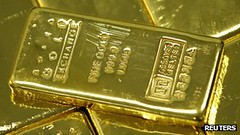 Twenty "gold" bars found in a case on a train near Paris last week have been found to be fake.
Twenty "gold" bars found in a case on a train near Paris last week have been found to be fake.
A suspect package on board an RER train at Massy-Palaiseau station was examined by the bomb squad and found to contain what seemed to be 20kg (44lb) of gold.
French police have now established that the bars are made of a base metal - with a thin coating of gold.
The ingots would have been worth around 800,000 euros ($1m; £670,000) if they had been genuine.
Police in Palaiseau, south-west of Paris, told Reuters news agency that they were not ruling out the possibility that the fake bars were part of a scam - in light of the worldwide demand for gold.
To read the complete article, see: Mystery 'gold ingots' found on Paris train are fake (www.bbc.co.uk/news/world-europe-16392922)
ARTICLE HIGHLIGHTS WASHINGTON'S BOOKHOUSE
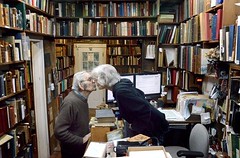 The title is "A Descriptive and Illustrative Catalogue of Chinese Bronzes Acquired During the Administration of John Ellerton Lodge." Brown cloth with gilt titling. It is somewhere among the 30,000 volumes in the Bookhouse, which is exactly what it sounds like: a 100-year-old house collared by ivy and packed with antiquated books, hidden on a side street off Wilson Boulevard in a strip-malled stretch of Arlington.
The title is "A Descriptive and Illustrative Catalogue of Chinese Bronzes Acquired During the Administration of John Ellerton Lodge." Brown cloth with gilt titling. It is somewhere among the 30,000 volumes in the Bookhouse, which is exactly what it sounds like: a 100-year-old house collared by ivy and packed with antiquated books, hidden on a side street off Wilson Boulevard in a strip-malled stretch of Arlington.
Edward, 91, heads to the stairs.
"They're never where they should be," says Natalie, 80, watching him begin the hunt. "Although sometimes they're exactly where they should be."
Natalie was born in the Philippines into a military family and lived on a series of air bases growing up. The itinerant lifestyle forbade the accumulation of possessions. This may be why she made a life out of acquiring and amassing books, she thinks.
In 1968, on a whim, she bought 3,000 books for $40 at a hotel liquidation in Bar Harbor, Maine, intending only to read them. Then she bought "Gold in Your Attic," a guide to collecting books.
She was behind the counter in her first shop two years later.
Edward retired from the Transportation Department in 1973 and decided that he would raise broadleaf evergreens as a hobby. Natalie had a robust collection of botany books at her bookstore, in a new location on Irving Street in Arlington. They met as customer and shopkeeper.
"I liked him," she says. "I would find books he was looking for, and I would use that excuse to call him at home to see if a woman ever answered. None ever did."
Their first date was a hike in Turkey Run to see the ferns. They were married within a year. Edward got hooked on the book business. He and Natalie moved the operation to the Bookhouse on Emerson Street in 1975. The Washington region is a prime spot for book dealers, Edward says, because aging military officers would rather sell or donate their ephemera than pay to ship it to their retirement destinations.
Collecting books is a passion inspired by what's not on one's bookshelf, says Bruce McKinney, the proprietor of Americana Exchange, an online database of 3.4 million titles.
"And it's never complete," McKinney says. "Particularly in the age of the Internet, we are delving more and more deeply into these subjects," and the ability to find material is almost limitless, and "the enormous availability is redefining what's collectible." (The second-most-expensive antiquated book purchased at auction last year was a comic book: Issue No. 1 of Action Comics, which introduced Superman to the world in 1938, sold for just over $2 million.)
About $381 million in books, manuscripts and ephemera were sold at U.S. auctions last year, a healthy and stable sum, according to McKinney, especially given the state of the economy. What's changing most about the old-book business is the closure of storefronts. If Borders can't stay in business , there isn't much hope for other bookseller storefronts. Public places of perusal are vanishing. In the '80s, in Georgetown and certain parts of Northwest, you'd have five antiquarian bookshops within walking distance of one another, says Allan Stypeck, owner of the 37-year-old Second Story Books.
"It's an eccentric interest, and individuals go into them as a hideaway from reality," Stypeck says. To time travel. To obsess over the minutiae of a particular subject.
"My wife's just finishing editing the 200-year history of our church in Washington, and we could always count on the Bookhouse to have the best primary source material available," says Dave Snyder, vice mayor of Falls Church. "There's nothing like having a book in your actual hands that was owned by a member of the Civil War unit that the history pertains to. It's the ability to reach out and touch history, and no online version of a book can match that."
To read the complete article, see:
Venerable Bookhouse owners share a life among the stacks
(www.washingtonpost.com/lifestyle/style/venerable-bookhouse
-prepares-to-close/2012/01/03/gIQAHAPGZP_story.html)
THIEF PUTS COLLECTION INTO COINSTAR MACHINE
Police in Oregon are searching for a suspect who allegedly stole a rare coin collection from his own father and traded it in for pennies on the dollar at a local coin-counting machine.
On Christmas day, Dan Johnson Jr. and two friends allegedly broke into a shed on his father's property, where the coin collection was stowed. The burglars also reportedly stole tools and two safes, which had approximately 50 to 60 pounds of silver and jewelry inside.
So what explains the colossal miscue? Authorities say that the simplest explanation is the most persuasive one. "The obvious answer is that the crooks were idiots," Dan Johnson Sr. told local affiliate Fox 12. "To not know the value of what they had taken, just to get pocket change for it. Just really a stupid person. Makes me feel good he was a stupid person and didn't realize what he had."
The thieves took the coin collection, worth several thousand dollars, and dropped it into a Coinstar machine, where they received $450. They were unsuccessful in their attempts to put the silver coins into the machine and eventually took those to a local bank.
To read the complete article, see:
Thief drops stolen coin collection into Coinstar machine
(news.yahoo.com/blogs/sideshow/thief-drops-stolen
-coin-collection-coinstar-machine-154615597.html)
WALMART CUSTOMER SPENDS $1 MILLION BILL (OR TRIES TO)
Talk about leaving the store with a big chunk of change.
A Lexington man is accused trying to use a fake $1 million bill to pay for his purchases at a Walmart.
Michael Anthony Fuller, 53, of 3 Parker St., walked into the Walmart on Lowes Boulevard in Lexington on Nov. 17. He shopped for a while, picking up a vacuum cleaner, a microwave oven and other merchandise, totaling $476, an arrest warrant says.
When he got to the register, Fuller gave the cashier the phony bill, saying that it was real.
Store staff called police.
Fuller was later charged with attempting to obtain property by false pretense and uttering a forged instrument, both felonies, court records show.
A warrant says of the fake million-dollar bill: "There is no such thing."
The largest bill in circulation is a $100 bill. In 1969, federal officials discontinued the use of $500, $1,000, $5,000 and $10,000 bills because of lack of public use.
Fuller was being held Friday night in the Davidson County Jail with bond set at $17,500. He is scheduled to appear in court Tuesday.
To read the complete article, see:
Lexington man charged with making a fake $1 million bill and trying to spend it
(www2.journalnow.com/news/2011/dec/31/wsmain01
-lexington-man-charged-with-making-a-fake--ar-1765473/)
FEATURED WEB SITE: THAMES AND FIELD METAL DETECTING SOCIETY
This week's Featured Web Site is the Thames and Field metal detecting society. We featured the site back in March 13, 2011, but they now have a new web address. Thames and Field member Nick Stevens writes:thamesandfield.com is the official site of Thames and Field metal detecting society. We are a club who mainly go Mudlarking on The River Thames Some of our members are also members of the Society of Thames Mudlarks.
The site includes more information on what we do as well as lots of pictures of some of the finds we have made. All of our members have made finds that have been recorded with the Museum of London and through our finds, many of which are unique, we are regularly adding to our Capital's history.
We have also just finished filming the second series of Mud Men for the History Channel which will air in the UK towards the end of January 2012.

www.thamesandfield.com
